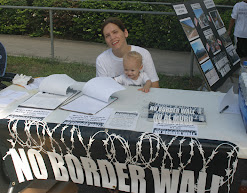In response to mounting criticism, the
U.S. section of the International Boundary and Water Commission (IBWC) has
agreed to host a public meeting to discuss their decision to approve the
construction of border walls in the Rio Grande floodplain.
The
meeting will be held on Wednesday, August 29, from 6:00-8:00pm in Rio Grande
City at the Holiday Inn Express located at 5274 East Highway 83.
Rio Grande City, along with Roma and
Los Ebanos, will see miles of border wall built in the floodplain adjacent to
homes, farms, and businesses. These new
walls will also repeatedly slice through the Lower Rio Grande Valley National
Wildlife Refuge.
Since 2007 both the U.S. and Mexican
sections of the International Boundary and Water Commission have rejected the
construction of walls in the Rio Grande floodplain due to concern that during a
flood event they would act as dams. In
the United States water could be trapped in communities, unable to drain into
the river. Flood water could also be
deflected into Mexico, worsening flooding there, and potentially pushing the
river into a new channel, which would change the location of the international
border.
IBWC demanded that walls built in
other parts of south Texas either be placed north of the levees or inserted
into them, so that they would not impact flooding. Roma, Rio Grande City, and Los Ebanos are not
protected by levees, so walls have not been built there.
In February of this year the U.S.
section of IBWC caved in to years of pressure from Customs and Border
Protection and reversed their rejection of these walls. Mexico continues to reject these walls. If the U.S. acts unilaterally it will be in
violation of the treaty that established the border.
U.S. IBWC claims that a flood model
commissioned by Customs and Border Protection in July 2011 shows that if the
Rio Grande were to engulf border walls after a hurricane, debris lodged in the
walls would only block 10-25% of the water.
That model contains no explanation of where this number came from. By starting with the assumption that walls
will not block water, the result of the computer model is essentially predetermined.
In Arizona Customs and Border
Protection have constructed nearly identical border walls – 6-inch wide posts
with 4-inch gaps between them – across a number of washes. In places these walls have trapped debris to
a depth of nearly six feet. Walls then
act as dams, diverting water into nearby homes and businesses or causing severe
erosion. U.S. IBWC should explain how it
is that walls of the same design trap debris and act as dams in the real world,
but allow water to pass harmlessly though in the computer model that they are
relying upon.
These
walls have the potential to do serious damage to communities and refuges near
Roma, Rio Grande City, and Los Ebanos.
The Sierra Club Borderlands Team and No Border Wall urge RGV
residents to attend this public meeting and ask the U.S. IBWC tough questions. These decisions are being made in Washington
DC for political reasons, but it is our homes, and possibly even our lives,
that are at stake.
#####
For more
information about these border walls, please read the recent Texas Observer
piece:
